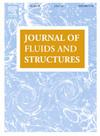Experimental investigation on fluid–structure interaction in highly flexible wings
IF 3.4
2区 工程技术
Q1 ENGINEERING, MECHANICAL
引用次数: 0
Abstract
This paper presents a comprehensive experimental investigation of fluid-structure interactions in a flexible, high-aspect-ratio wing during its post-critical phase, spanning a reduced velocity range of and corresponding Reynolds number range of . The angle of attack of the wing was systematically varied from 0° to 20° in increments of 2°. The structural dynamics results reveal that changes in the angle of attack significantly affect the onset of limit cycle oscillations, as well as the dominant oscillation frequencies and mode shapes. At higher flow velocities and angles of attack, a significant increase in tip deflection was observed, while minimal deflection occurred at lower or zero angles of attack. In addition to examining the structural responses, the study employs volumetric, time-resolved particle tracking velocimetry (TR-PTV) to investigate the three-dimensional (3-D) flow field around the wing and its wake. Vortex behavior and its interactions with the structural modes varied with different angles of attack and reduced velocities. Leading and trailing edge vortices adapt to wing deflection, particularly at higher angles, and the coherence of these vortical structures was shown to be influenced by the amplitude and mode shape of the wing’s oscillations.
高柔性机翼流固耦合实验研究
本文对柔性高展弦比机翼后临界阶段的流固耦合进行了全面的实验研究,其速度范围为U∗=1.47 ~ 35.34,相应的雷诺数范围为Re=146 ~ 3,499。机翼的迎角系统地从0°变化到20°,增量为2°。结构动力学结果表明,攻角的变化显著影响极限环振荡的起始,以及主导振荡频率和模态振型。在较高的流速和迎角下,观察到叶顶偏转显著增加,而在较低或零迎角下发生的偏转最小。除了研究结构响应外,该研究还采用了体积、时间分辨粒子跟踪测速技术(TR-PTV)来研究机翼及其尾迹周围的三维流场。旋涡行为及其与结构模态的相互作用随攻角和降速的不同而变化。前缘和后缘涡旋适应机翼偏转,特别是在较大角度时,这些涡旋结构的相干性受到机翼振荡幅度和模态形状的影响。
本文章由计算机程序翻译,如有差异,请以英文原文为准。
求助全文
约1分钟内获得全文
求助全文
来源期刊

Journal of Fluids and Structures
工程技术-工程:机械
CiteScore
6.90
自引率
8.30%
发文量
173
审稿时长
65 days
期刊介绍:
The Journal of Fluids and Structures serves as a focal point and a forum for the exchange of ideas, for the many kinds of specialists and practitioners concerned with fluid–structure interactions and the dynamics of systems related thereto, in any field. One of its aims is to foster the cross–fertilization of ideas, methods and techniques in the various disciplines involved.
The journal publishes papers that present original and significant contributions on all aspects of the mechanical interactions between fluids and solids, regardless of scale.
 求助内容:
求助内容: 应助结果提醒方式:
应助结果提醒方式:


